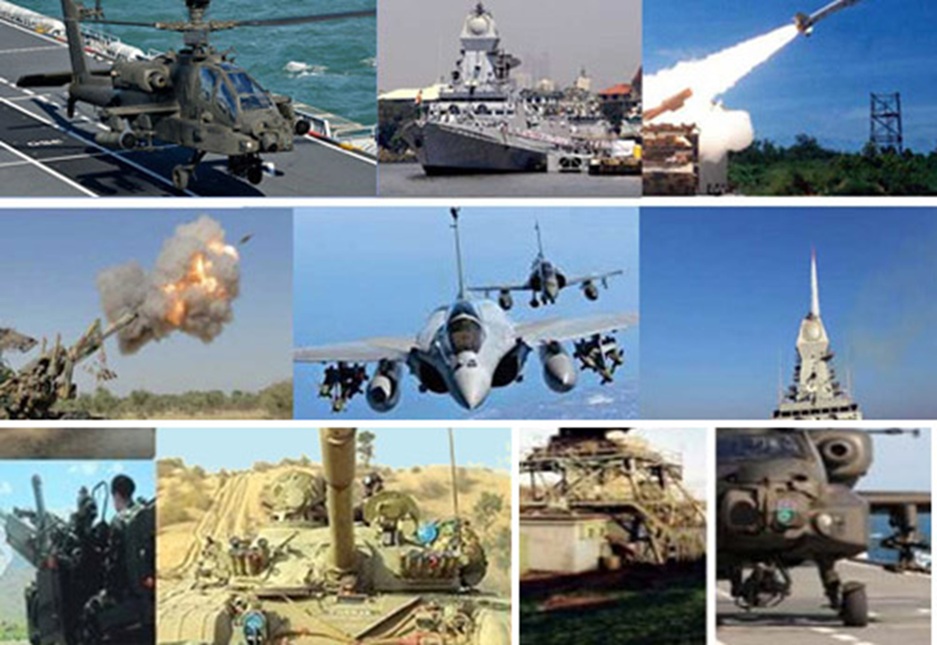Artificial Intelligence has become more popular after the launch of ChatGPT and DALL-E by OpenAI. These tools showed us the potential of generative AI over traditional or conventional AI.
Generative AI is focused on generating new working data/content rather than making predictions based on existing data. It uses machine learning models to create original content such as images, videos, text, music etc. Generative AI models are trained on large datasets and these models can generate new content that is similar to the contents on which they were trained. Hence Gen AI is good for the generation of creative content, data augmentation, image processing, text generation and much more. This has opened up a whole lot of applications for defence and aerospace.
Image and Video Generation
Deep learning models like Generative Adversarial Networks (GANs) and Variational Autoencoders (VAEs) can be used for military-specific images and videos. These generative models can create synthetic visuals, which can be valuable for data augmentation, simulation and training purposes. AI-generated images and videos can be used for deception operations or disinformation campaigns to mislead adversaries and protect their own sensitive information. These models can help generate virtual training environments, target and threat simulation and even create synthetic satellite images, aerial footage or surveillance data to simulate various intelligence and reconnaissance scenarios. It can generate synthetic video streams for autonomous navigation, target tracking and even for situational awareness. It can even develop camouflage patterns and techniques to improve the concealment of military assets as well as create synthetic visual deception strategies to confuse adversaries.
Data Augmentation
Generative AI can be used to augment datasets for training machine learning models used in various military applications such as object recognition, target identification and autonomous systems. This process will enhance the diversity and quantity of training data available for machine learning models in various military applications which would improve the performance and robustness of machine learning algorithms by artificially expanding the dataset. This is inevitable where the collection of large amounts of real-world data is challenging or risky. The data sets can be images, audio clips, videos or even texts.
Strategic and Operational Planning
Generative AI can aid in generating diverse scenarios and predicting potential outcomes during strategic planning, war gaming, and decision-making processes. Models can be employed to simulate various military scenarios, taking into account factors like terrain, weather conditions, enemy positions and friendly forces. Simulations can help military planners explore potential outcomes and identify optimal strategies. AI can also generate alternative courses of action for military operations and air combat based on available data and historical patterns. This can provide military planners with a broader range of options for developing strategic plans. Models can even help to assess risks and allocation of optimal resources for operational tasks.
By analyzing historical data and current intelligence, generative AI can offer predictive insights into potential enemy actions and responses, helping military planners anticipate and prepare for various contingencies. Gen AI, combined with natural language processing, can assist in analysing large volumes of intelligence data like reports, satellite imagery and intercepted communications to identify patterns and trends relevant to strategic planning. It would facilitate integration across different military domains, such as land, sea, air, space, and cyber, allowing military planners to develop comprehensive and coordinated strategies.
Simulation and Training
Generative AI can create highly realistic and dynamic training environments for military missions. This includes generating virtual battlefields, adversaries and scenarios to train soldiers/pilots to improve their tactical decision-making skills. These models can be used to create realistic and diverse training scenarios like terrain conditions and even enemy behaviours. It can create environments that can simulate complex, dynamic scenarios which allow military personnel/pilots to practice decision-making and tactical skills in a safe and controlled setting. Synthetic data can be created for training machine learning models that aid military applications like target recognition and intelligence analysis. It can even simulate enemy tactics and strategies based on historical data or own expert knowledge which would facilitate developing counter-strategies.
Autonomous Systems
Generative AI can be employed to enhance the capabilities of autonomous systems like UAVs, autonomous underwater vehicles and ground vehicles, enabling them to adapt to changing environments and scenarios. Generative AI is used to create realistic virtual environments, where autonomous systems can undergo training and testing. These simulations enable the platforms to practice navigating complex airspace and terrains, encountering diverse scenarios and learning from virtual challenges without any risks associated with real-world training. These models can enhance the algorithms’ ability to recognize and interpret real-world visuals. It can help autonomous systems predict and adapt to various environmental conditions and obstacles in real time, improving their ability to navigate complex terrains and unknown airspace. Any deviations from these learned patterns can also be detected. By learning from a wide range of simulated scenarios, these models can generate adaptive strategies for dynamic environments and mission objectives. Models can simulate realistic adversary behaviours and tactics for autonomous systems, which can be taught to anticipate and respond to potential threats in real time. These models enable adaptive decision-making and the ability to respond to changing environments and threats.
Natural Language Generation (NLG)
NLG can be utilized to create automated reports, summaries and analyses from vast amounts of raw intelligence data, assisting military analysts in decision-making and situational awareness. NLG models can be used to develop machine translation systems for real-time communications between different languages. This is particularly useful for military operations and intelligence analysis during joint exercises. Sentiment Analysis helps military personnel understand public perception, assess the impact of operations, and monitor sentiment within the ranks. Named Entity Recognition (NER) assists in intelligence analysis, tracking key individuals and understanding the affiliations of various entities. NLG helps military commanders generate intelligent reports for quick eyes. Chatbots for assisting soldiers with expert systems, Speech-to-Text and Text-to-Speech conversion wherever necessary including multilingual communications, threat analysis and fake news detection are other possible NLG applications.
Deception and Stealth Technology
AI-generated models can assist in designing and optimizing stealth technology, helping military aircraft and vessels evade detection by radar and other sensors. The AI models could generate and evaluate numerous design variations, seeking shapes, materials, and configurations that minimize radar cross-sections, infrared signatures and underwater sonar signatures while maintaining performance requirements. Generative AI could be utilized to create camouflage patterns that blend seamlessly with various environmental backgrounds, making it difficult for adversaries to detect and identify military assets. Generative AI might be employed to generate decoy signals or signatures that mimic real military assets. These decoys could divert enemy attention and confuse their targeting systems. Models could be used to optimize communication protocols and strategies for stealthy communications, making it harder for adversaries to intercept or detect military communications. Generative AI might assist in designing and optimizing electronic warfare systems that jam or disrupt enemy sensors and communications.
Electronic Warfare
By generating signals and emulating various communication and radar signals, generative AI can be used to test and improve electronic warfare systems. Generative AI can be used to optimize electronic warfare systems that perform jamming of enemy communication and radar signals. They can analyse signal characteristics and adapt jamming strategies in real time to counter evolving enemy countermeasures. Models can process and analyse large amounts of electronic signals, classifying them based on the type of emitter, frequency, modulation, and other characteristics. This helps in identifying potential threats and determining the appropriate response. It can assist in managing the electromagnetic spectrum efficiently by predicting and preventing congestion, interference, and overlap of friendly signals. It can even create realistic decoy signals to mimic friendly or enemy electronic emissions, confusing adversaries and making it harder for them to identify real targets.
Gen AI can be used for Cyber Electronic Warfare (CEW) by creating synthetic cyber attacks and responses, enhancing the understanding of cyber threats and defences. A large amount of ELINT data comprising intercepted radar signals and communication intelligence can be analysed to extract meaningful information and identify patterns relevant to electronic warfare operations. Generative AI can enable electronic warfare systems to adapt to changing airspace scenarios/battlefield conditions, learn from past engagements and adjust their strategies accordingly. It can also be used to develop Electronic Counter-Countermeasures (ECCM) to counter the adversaries to neutralize the ECM efforts. Even signal denial and deception can be done for adversaries to detect friendly signals or identify the location of enemies’ electronic warfare assets.
Predictive Maintenance
AI can generate predictive models to forecast equipment failures and maintenance requirements, ensuring optimal military asset readiness and availability. It can analyse historical sensor data from equipment and systems to learn normal behaviour patterns with the new data. It can also detect anomalies or deviations from expected behaviour, indicating potential equipment malfunctions or impending failures in advance. Gen AI can process real-time sensor data from military assets and platforms such as temperature, pressure, vibration and other parameters. Models can predict potential failure modes and patterns based on historical failure data. By understanding the common failure scenarios, maintenance strategies can be tailored to address these specific issues proactively. AI can even estimate the remaining useful life/residual life of critical components and equipment. It can simulate different operating conditions and scenarios to forecast future equipment performance and predict maintenance requirements accurately. Models can even augment sensor data to mimic real-world conditions.
Optimization of Maintenance Schedules can be done by Generative AI by analysing historical maintenance data and equipment performance to optimize maintenance schedules. It helps determine the most cost-effective time to perform maintenance activities while minimizing disruptions to operations. It can assist in Root Cause Analysis(RCA) as well as Prognostics and Health Management (PHM) for aircraft and military assets.
Cybersecurity
Generative AI can be also used to simulate cyber-attacks and assess the resilience of military networks, systems and software against various threat scenarios. Generative Adversarial Networks (GANs) can be used to generate adversarial examples that can help in evaluating and testing the robustness of machine learning models. Can be trained for intrusion detection, anomaly detection, and malware detection. We can even generate realistic honey-pots and deception techniques to divert attackers’ attention and gather information about their tactics, techniques, and procedures. Models can analyse, detect and predict phishing emails or messages and alert users and military personnel about potential social engineering attacks.
Conclusion
Above mentioned applications can be ventured only if the military has a captive private cloud and very high-quality primary data for learning. If not carefully trained or supervised Gen AI models can produce biased or inappropriate content/ wrong outputs. Henceforth a responsible deployment is crucial in generative AI systems, especially on military-associated applications. There is a huge opportunity for academia and startups to collaborate with defence towards exploring each and every application mentioned above.
Disclaimer: The views and opinions expressed by the author do not necessarily reflect the views of the Government of India and Defence Research and Studies
Title image courtesy: Analytics insight







